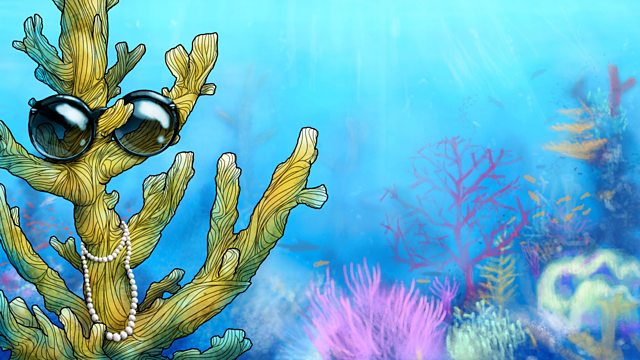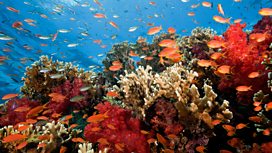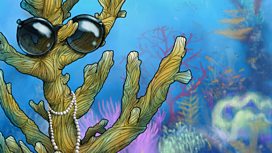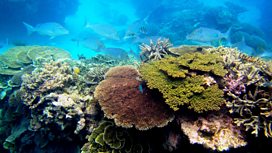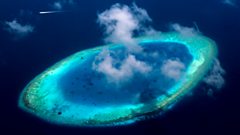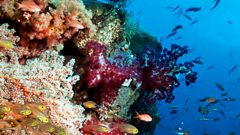Coral
Brett Westwood explores the beautiful and dark sides to tropical coral reefs, from shipwrecks to paradise. From 2015
Coral can take on many forms from branching, tree like structures to flat table tops. They are colourful and bright, often described as underwater gardens. Yet they are double edged beauties. Their ragged structure tore the hulls from wooden ships, causing the death of many sailors. Poisonous fish lurk amidst the beauty and sharks patrol the edges. Charles Darwinβs ship The Beagle had the task of mapping coral reefs, so dangerous were they to shipping, and they formed the topic of his first book. Darwin couldnβt see the reefs underwater, but he still managed to work out how they formed, leaping from top to top with the aid of a βleaping stickβ.
Coral has entered our literature with tales of paradise islands, from Ballantyne's The Coral Island in the 19th century to Golding's Lord of the Flies. More recently coral reefs were the setting for the film Finding Nemo, a film so popular it set off a craze for clown fish as pets, causing real concern for the future of clown fish on many tropical reefs.
But no matter the reality, we seem to crave the vision of paradise that coral reefs provide. They will always be glorious places in our hearts and minds.
Originally broadcast in longer form 21 July 2015
Archive producer for ΒιΆΉΤΌΕΔ Audio in Bristol : Andrew Dawes
Last on
![]()
From tiny polyps to massive reefs - 10 things to learn about corals.
![]()
The World According to Coral
Natural Histories comedy with Harriet Carmichael.
![]()
The Future of Corals
Coral reefs are renowned for their beauty and diversity but what is their future?
![]()
Saving Coral
Marine Biologist Mary Hagedorn has an innovative plan to save the coral reefs.
Clips
-
![]()
How corals get their colours
Duration: 00:41
-
![]()
How coral islands are formed
Duration: 01:43
-
![]()
The coral reef battlefield
Duration: 01:01
-
![]()
How corals grow
Duration: 00:57
Dr Kenneth Johnson

He has collected new data from modern and fossil coral reefs in the Caribbean and Southeast Asia to constrain future modes of change in reef ecosystems as they respond to accelerating human impacts.
Ken has published more than 50 research papers in major scientific journals including Science, Geology, Bioscience, Proceedings of the National Academy of Sciences, and Coral Reefs.
Jason DeCaires Taylor

Following on in 2009 he co-founded , a museum with a collection of over 500 of his sculptural works, submerged off the coast of Cancun, Mexico.
Taylorβs art is a paradox of creation, constructed to be assimilated by the ocean and transformed from inert objects into living breathing coral reefs, portraying human intervention as both positive and life-encouraging.
Dr Erica Hendy

She specialises in documenting past climates and environments, and identifying how the ecosystem responds. Much of this information is recorded in the skeletons of massive coral colonies.
Professor Ralph Pite
He is currently writing a book about the poets, Robert Frost and Edward Thomas. They were close friends in the three years before Thomasβs death in 1917, at the Battle of Arras. Both men shared a love of nature and an interest in βthe simple lifeβ β in ways of living, which we would call sustainable.
Broadcasts
- Tue 21 Jul 2015 11:00ΒιΆΉΤΌΕΔ Radio 4
- Mon 27 Jul 2015 21:00ΒιΆΉΤΌΕΔ Radio 4
- Sun 18 Sep 2022 06:35ΒιΆΉΤΌΕΔ Radio 4
Featured in...
![]()
Under the Sea
Programmes about the deep.
